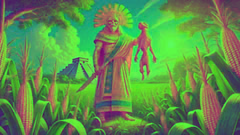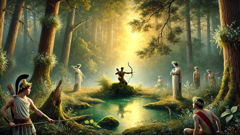Introduction
Long before the names of villages had been spoken and before coconut palms hung heavy with fruit, there was Degei—coiled in the depths of what would become the highest mountain ridges. He was not merely a creature but a presence that held the first measure of time in his chest. The sea remembered his scales, the wind learned the pattern of his breath, and the stones bore the faint prints of his passage. Islanders say Degei came from the place where night and salt meet, a seam in the world only the oldest tides could remember. In those first days he slept beneath an island of black stone. From his dreams came rivers, from his sighs came rain, and from his movements islands rose like islands of thought given body. People would later come to him as children come to a stern parent—both frightened and reverent—because his stirrings made the earth shiver and because his judgments shaped destinies. This is a telling of that early world: how Degei shaped the Fiji Islands, fashioned the first people from clay and chant, and taught them the language of offerings and the proper curve of respect. In these chapters you will meet the mothers of villages who remembered how to speak to the serpent, the fishermen who learned to read the language of ripples as warnings, and the young who dared to follow him into hidden caves where the world narrows to a truth. I will trace the cords between creation and custom, between tremor and myth, and show how each quake remains a conversation between land and its oldest guardian. Keep the image of a long body uncoiling through mist and stone: that is the spine of this tale, a living map that explains not just the shape of islands but the shape of duty in the bones of a people.
The First Winding: How Islands Were Spoken into Being
When the world was still a question, Degei moved like an answer. The earliest stories say his body was longer than any reef and darker than the belly of a storm. He lay along a seam where ocean and sky conferred in whisper and his scales were mottled with the first minerals the earth would ever know. There was no map yet, only motion; no names, only the insistence that something should be. Degei opened his mouth and the sound became a current, carving channels through waters that had no borders. Those currents gathered here and there, and where they curled they found places to cool and harden. The islands were spoken into being not by a god who drew them like a potter shapes clay, but by one who chose where to rest and where to roll his weight. Each time his coils tightened, a ridge rose; each time his tail thudded, an atoll grew tall enough for birds to call upon. If you stand now and look at a pattern of reefs on a clear day you will see the echo of those ancient turns—a living fingerprint.

The people who later told the tale of Degei never spoke only of the dramatic. Their accounts are full of details that anchor the spectacle to ordinary life. They explained that the first seas were thick with a kind of salt-scented fog, that certain weeds grew only where a scale had brushed the seabed, and that some stones had the sheen of a serpent's eye because they had tasted his skin. Elders would point to an oddly shaped headland and say, 'There he coughed once and the water set like glass,' and children would laugh at the thought, but they also kept a respectful distance; they had heard, too, how Degei's anger could twist the coastline where it had been soft.
There are several episodes the stories return to, each told with variations like different fishermen telling where the big fish lies. One tells of Degei's first sigh, which filled low basins with mist. From that mist rose plants whose leaves could catch dew the way hands catch small coins. From those plants came colors, and with color came names, and with names came stories. Another remembers the first time Degei rolled inland and created a mountain that looked like a sleeping elder. The mountain became a place where the land remembered its ancestors; winds that passed along its shoulders carried the names of the dead down to villages. People visited the slopes and left offerings of woven mats and plates of roasted taro, not because they feared being eaten but because they believed the mountain-serpent kept the ledger of who had taken from the sea and who had given back.
The myths teach that Degei did not sculpt people out of nothing. He made them from the things that gathered where his body had touched the land—the fine red clay of river mouths, the softened coral dust from reefs, the fibers of woven leaves that had caught on his scales. He breathed over these mixtures and, in his breath, embedded rhythm: a cadence that became heartbeat. The earliest people did not awake shouting but counting in slow, sea-borne measures. Their first songs were imitations of waves and coil-turns; they spoke names of places the way one speaks of relatives. They learned to plant in terraces where the serpent had left humps of good soil, and to avoid the low gutters that marked where his coils had been too thin, where crops would fail. In such small and persistent ways the presence of Degei organized life.
To the people, creation and caution came as a single instruction. The land was generous where Degei had been gentle, and dangerous where he had been restless. So they learned a multitude of rituals that were less pleas than protocols: how to greet a river mouth at dawn with a song that mimicked a ripple, the proper angle to lay a mat before an offering so that the spirit of the serpent might pass above without tripping the loose edges, which shells were acceptable to leave and which were to be taken only after a certain chant. Each village possessed a set of verses, a small lineage of words that passed from fisher to fisher, grandmother to child. Those words shaped life, regulated marriages, and decided when to harvest breadfruit. In essence, to live in these islands was to live in conversation with Degei without always naming the deity explicitly.
There are stories of dispute, too. Once, so the elders relate, men from three separate bays quarrelled over a particularly fruitful reef. They cast lots and sailed to the headland where Degei slept. Bringing offerings of baked fish and intricately carved combs, they spoke in a chorus of respect and request. The serpent curled his ear—some say serpents have ears of stone—and listened. When a tremor shuddered through the sand, the people took it as a sign. The reef shifted in the coastal bed a few months later, producing fewer fish on one side and more on another, a patchwork of fortune that reflected Degei's refusal to be bargained with. The men learned to read the subtle language of tremor and tide: certain shaking meant 'be cautious', other shaking meant 'move', and deep, rolling quakes meant 'remember who made you'. Thus they came to an understanding that the serpent's responses were as much an act of instruction as of power.
What scholars and storytellers often miss is how the myth teaches proportion. Degei is not only a force of destruction; he is a measure of reciprocity. When villagers sang at the base of a hill, the rains answered. When they brought offerings in the season of breadfruit, their weave held longer and infants cried less. The old songs that remain to this day are filled with practical details: 'If you speak with a child at dawn and show him the path to water, do not let him walk in the shadow of the tall tree alone'—not a mystical injunction so much as an admonition, folded into myth so it would endure. The stories engrain that survival and reverence are braided like the cords of a mat. That is Degei's first enduring lesson: the world is generous when reciprocity is kept, and brittle when the cords are cut.
Even now, if you climb certain ridges and press your palms to a warm stone, elders will tell you the feel of the scale in the rock. They will hum a short chant and make a small offering of salt. The ritual might seem small—a pinprick of habit against a vast cosmology—but those small things are how the living people of the islands maintain a relationship with a force older than their language. And so the islands remain shaped not only by tectonic law but by a long practice of remembering that the earth beneath your feet is a body that moves in patterns of will and memory.
The People and the Tremor: Ritual, Law, and the Serpent's Judgment
Degei's second telling concerns the people who learned to listen. The early villages came to be near the places where the serpent's mood was best understood: ridgelines where he slept long and coasts where he uncoiled at low tide. Life in these communities was organized by calendars that measured the serpent's habits. A particular set of stars would signal when Degei would move northward in his sleep; certain birds would fly and not return until the tremor season passed. Through generations, this knowledge became layered—an archive encoded in song, in braided cord patterns, and in the names of taro patches. To the outside eye these practices look like superstition, but in fact they are bodies of knowledge tuned to living land.

There are many stories of how people came into Degei's grace—or fell from it. One such tale speaks of a woman named Laisa, who understood the language of currents. Laisa would wade at dusk and follow the eddies, reading the way small fish turned like punctuation marks. She learned that a certain pebble by the reef hummed faintly when Degei dreamed of the sea; she kept it wrapped and only brought it out when the village was sick. In the year when breadfruit failed across three bays, Laisa went before the elders and unwrapped the stone. She sang an old chant that the elders claimed had been taught to their grandfathers by a man who once watched a serpent cross the horizon. As she sang, rain gathered in a thin line on the far side of the mountain and the island exhaled a long, wet sound. Crops revived where Laisa's song had pointed, and the people built a small house of remembrance at the edge of the reef for her and the stone.
Yet not all stories celebrate human cleverness. Many warn of hubris. There is an oft-told account of traders who, in haste and greed, stripped a sacred grove for timber to build a house that would look richer than their neighbors'. They chanted no offering, they left no salt, and they cut down trees that grew upon a hump where Degei had once napped. That night, the earth under their new house sank slightly, doors would not latch, and water gathered in the corners as if the house were a shallow pool. The traders’ livestock fell ill and a tremor uprooted a nearby breadfruit tree. The guilt of the men became heavier than the wood they had stolen. Only after they returned a carved statue and planted a double ring of young cocos did the land settle; it was taught that restitution must match transgression, that a stolen part of the world must be paid for by creating something that the serpent would accept as of equal weight. Such stories functioned as law, a moral geology.
Degei's judgment had forms. Sometimes it was a quake that toppled a poorly sited house; sometimes it was a slow wasting of fish near a reef that had been overharvested. In one famous tale, a chief named Ratu built his house of stone on a slope where Degei liked to sun himself. Ratu thought himself safe because the house was of stone and stone is enduring. He had ignored the old instructions: to leave a ribbon of land unpaved for the serpent to rest, to sprinkle crushed coral at the threshold for luck, and to place a carved comb on the roof to distract any hungry spirit. Not long after, a series of tremors pushed the house partway down the slope until it leaned like a tired elder. Ratu apologized publicly, exacted a penance of taro and matting, and decreed that henceforth the ribbon of land must be left at the foot of each new house in his domain. The story persists because it is a practical example of the balance between human ambition and natural order.
Ritual, then, is the grammar of coexistence. That grammar includes rites of passage and the daily smallness of respect. When a child reaches the age to weave an adult mat, the community gathers and sings a line of song about coils and measurement. The song includes the names of places where Degei once rested; speaking those names aloud anchors the child's work in the memory of the land. Weddings are celebrated with a different tune, one that asks Degei to smooth the path forward rather than roll a stone into it. Funerals, conversely, are conducted with the recognition that when a body returns to the earth it enters the serpent's precincts; elders recite a litany that maps the dead onto the serpent's backbone, ensuring their names ride the currents of memory.
Religious specialists played a role too—men and women who were taught to listen more patiently than others. They learned to read patterns in algae bloom, the angle at which sea birds perched, the heat of certain stones. These specialists kept books of chants, though rarely in ink; their books were woven mats that encoded instructions through knot and color. Initiates learned to move their mouths and their hands in sequences set down by these mats. Through a lifetime of listening, some elders claimed they could tell the difference between a shaking caused by fish and one caused by Degei's irritation.
This interplay between ritual and observation had practical consequences when Europeans first visited the islands. Early contact often misread the practices as quaint superstition. But the islanders were less interested in converting strangers than in preserving the conversation with the earth. As waves of new trades arrived—metal tools, foreign beads—some practices changed form without losing function. Iron axes, for instance, allowed quicker clearing of land, which made the serpent's displeasure more sudden. The old laws adapted; new offerings were added to account for the increased scale of action. Where a single household once sacrificed a woven comb, now a village might offer a carved plater of fish, a communal act that spread responsibility among many hands.
The serpent's power was never absolute. There are tales of cunning and compromise: fishermen who charmed Degei with a tune taught by a bird, children who hid a stone in the mouth of a cave so that the serpent would not coil there, midwives who warmed a child's path by placing a small woven mat where a coil had left shallow soil. These stories are not about defeating Degei but about learning his language well enough to live with him. When a tremor strikes today, villagers still look for warnings in the sky—birds flying long before the ground moves—or notice a certain stillness in the reef line. Those who know the songs sing soft notes into the dawn and perform small acts of feeding and mending. In this way, Degei remains less a distant law and more a living neighbor whose moods are negotiated daily. The tremor becomes a reminder that the world is not a stage but a body with a will of its own.
Over generations, the myth of Degei shaped laws, supported ecological knowledge, and taught a durable ethic: that listening is as important as speaking, that place remembers its use. Where modern science names tectonic plates and fault lines, the islanders remembered patterns in a different grammar. Both languages are partial; both are true in their ways. Degei's story persists because it bundles practical wisdom into a narrative form that people can carry in song and matting and practice. The serpent is a way to speak about consequences, and to remind that when you take from the world, you must also give back in forms the world recognizes.
Conclusion
To end this telling is to recognize that Degei lives wherever people remember him. He is both geography and grammar—a body that explains how islands exist and a series of practices that teach people to live within the consequences of their choices. The tremor is not merely a physical event but a sentence from a long-lived judge. The rituals are not superstition but structured responses that were refined over centuries of careful observation and reciprocal care. In modern times, we add new vocabulary—plate tectonics, seismology—yet the old stories preserve a different kind of knowledge: one that knits moral action to survival. When a child in a Fijian village learns to leave a small offering at a known coil, she is participating in a continuity that binds generations. That continuity matters because it teaches a reciprocal ethic: give to the land what you take, speak to the unspoken forces around you, and respect the scales beneath your feet. Degei, in his iterations, will remain both a caution and a benediction—a reminder that the world we walk on is alive, that it answers if we speak in the right tone, and that the tremors beneath us are not random but woven into an ancient conversation that, if listened to, will keep us steady long after any single generation is gone.
















